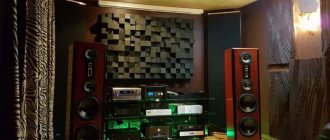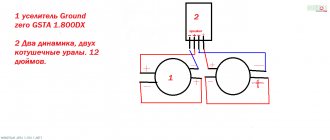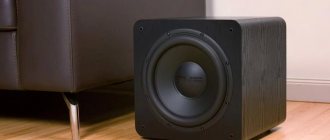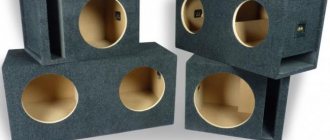About the importance of finding the right place for the subwoofer and a little theory
Why do you think we devoted an entire section of our article to the topic of proper placement of a subwoofer in a home theater? Absolutely right, because it's the location that has the biggest effect on the amount and quality of bass you'll hear in the end. The location of the main viewing location is equally important. All these difficulties are caused by the interaction of the objective physical properties of sound vibrations at low frequencies (wavelength) and the size of the room in which these vibrations are generated and propagated. To put it simply, in any room there are a priori resonances (layers of sounds) formed when sound waves are reflected from the surface of the walls and ceiling. standing waves are born , and it is their inevitable presence in any room that must be taken into account when looking for a place to install a subwoofer.
We will deliberately not complicate the story and limit ourselves to a description of nature and the influence of axial (axial) standing waves on the sound (besides them, there are also tangential and oblique waves). The frequency at which standing waves are present (aka modes or resonances) is determined by the distance between two parallel surfaces (for simplicity, we consider a rectangular room) and is calculated by the formula:
Resonant frequency = Speed of sound / 2 * Distance between surfaces.
For example, let’s take a room with a length of 6.6 m, a width of 3.3 m and a ceiling height of 2.6 m. After some simple calculations, we obtain the following first-order resonant frequencies for this room: 26 Hz, 52 Hz, 66 Hz. We take the speed of sound equal to 344 m/s. In addition, resonances are also present at frequencies that are multiples of the obtained base frequencies. For example, for 26 Hz it will be 52 Hz (26*2 – second order resonance) and 78 Hz (26*3 – third order resonance) and so on. The presence of resonance causes unevenness in the sound pressure level at a given frequency in different places in the room. There are places where the signal amplitude (loudness) will be maximum, they are called “nodes” or “peaks” . There are places where the amplitude is minimal, and the sound at a given frequency is practically inaudible - they are called “antinodes” or “dips .
The principle of the formation of standing waves between two parallel surfaces
A standing wave has the greatest strength and amplitude near the surfaces of the walls between which it originated. The total influence of different standing waves is most pronounced in places where planes intersect (wall with floor, ceiling with wall, one wall with another wall), and they have the greatest strength in places where three planes intersect, i.e. in the corners. Thus, a subwoofer installed in the corner will excite all possible room modes that lie in the range of frequencies it reproduces (theoretically, the LFE channel can contain sounds from 3 Hz to 120 Hz), and the bass that we hear will most likely be booming and inarticulate.
The distribution of standing waves in our experimental room is shown in the following figure:
Distribution of axial standing waves in the experimental room (the figure was created using the aximal mode calculator).
Let's return to the problem statement. Our goal, in case you forgot, is to achieve the effect of maximum immersion in what is happening on the screen. In terms of audio, this goal will be achieved when we can get sound in our home theater that is as close as possible to the original (how the sound engineer conceived and mixed the soundtrack in his control room). In turn, we can only get as close to the original as possible if we have a surround sound system whose sound is as linear as possible, i.e. uniformly throughout the frequency response graph. As a rule, the graph can be called linear if the amplitude values are within +-3 dB, for example this:
Variant of linear frequency response graph
In relation to the main topic of the article, all our attention should be paid to the range below 120 Hz. A good subwoofer frequency response graph should look something like this:
Linear graph of subwoofer frequency response
Now look at the picture we get when we place the subwoofer in the corner of our test room:
An example of a frequency response graph of a subwoofer installed in the corner of a room
The graph clearly shows the same room resonances we previously calculated at frequencies of 26 and 52 Hz, or rather “peaks” of 6-12 dB, which we hear at the listening location. Let us recall that an increase in sound pressure level by 3 dB (read more in our article “Sounds in a home theater. Loud or quiet?”) is perceived by the human ear as a twofold increase in volume. We believe that you can draw your own conclusions about the impact of a 12 dB “hump.”
How to make a room more comfortable with low frequencies?
The problem with low frequencies is the biggest headache for music lovers and home producers. The easiest way to curb bass is to absorb it in a large mass of porous material. This is usually done using mineral wool. To do this, bass traps made of mineral wool are installed in the corners of the room (where the bass accumulates the most). However, in a small room these traps will eat up half a meter from each corner. Not everyone will decide to take such a step.
If the problem is with a single frequency or range of frequencies that sounds noticeably louder, resonators will be more effective. For example, a diaphragm resonator is not very large in size, hangs on the wall and is a blank box with plywood in front. Inside there is a piece of mineral wool. The plywood membrane resonates with the desired frequency range and absorbs their energy. This can be calculated using a special calculator.
Helmholtz resonator - many have heard this term, and some car enthusiasts even use such a thing to suppress the hum of forward flow. In home and studio acoustics, Helmholtz resonators are used to precisely cut out a certain frequency in the bass range. The resonator looks like a hollow box or vessel with a hole; an audio wave enters it, the device resonates with it and “eats” it. If you make a hollow box and cover its front with boards, between which you leave gaps 0.5–3 cm wide (or simply drill holes of different diameters), you will get a Helmholtz resonator operating in a certain frequency range.
All these are professional methods that will take a lot of effort and time. There are simple, albeit less effective ways:
Recommendations for the location of a single subwoofer
How are we going to get out of this situation? Based on all of the above, one basic rule should be stated:
location of the subwoofer and the listening point must be chosen so that they are not located in the places of “peaks” and “valleys” of standing waves. It is especially important not to place them at nodal points at the intersection of two or more modes
(see figure of standing wave distribution above). In addition, there are a number of recommendations and techniques that allow you to achieve acceptable results. Here they are:
- The worst place to place a subwoofer is in the center of the room;
- The most difficult room to obtain a linear frequency response is a cubic one. Try to avoid equal or multiple room dimensions (especially if you have the opportunity to influence them during design and construction). The optimal ratios of room sizes to minimize the influence of standing waves are presented in the following table:
- As you start moving the subwoofer closer to the wall, the bass level will increase;
- You'll get the most bang for your buck by tucking the subwoofer into a corner. It is this installation that is recommended in the user manual of most inexpensive subwoofers that have a high lower frequency response limit and a low-power amplifier on board;
- The closer you move to the wall, the more bass your ears will perceive. You should never choose a viewing/listening location right next to the wall. If possible, move the sofa or chair so that there is at least 50-60 cm from the wall to your head;
- If the situation allows, as a starting point for placing the subwoofer relative to each of the planes, try to choose the one in which all the first three harmonics of the base resonance frequency are minimal:
Single subwoofer: places of minimal influence of the first three harmonics of the mode
- Do not place the subwoofer symmetrically relative to the walls of the room. Your sub will sound better if the distances from the installation site to the front, rear and side walls are different;
- If possible, still place the subwoofer closer to the front speakers. Even though low-frequency sounds are non-directional, the subwoofer will merge more easily and harmoniously with the main speakers if they are located in one part of the room.
“Subwoofer Crawl” technique
As you've probably realized by now, finding the optimal location for a subwoofer in your home theater room, media room, or personal cinema room will require some math and a little experimentation. In terms of experiments, one effective, albeit slightly extravagant method, originally called “Subwoofer Crawl,” will greatly help us. The gist of it is that you should use your listening location as a starting point in finding the optimal location for your subwoofer. The first thing to do is to position the subwoofer as close to your actual listening point as possible. If the situation allows, it is worth raising it to the same height at which your head is located when you sit. Next, you need to turn on playback of audio material you are familiar with (music or a movie with a lot of bass notes) and make sure that the subwoofer plays its part (for the purity of the experiment, you can even try turning off the rest of the speaker systems). Now you need to get on all fours so that your head is at the level where the subwoofer speaker is usually located, and begin to slowly move (the same Crawl) along the floor of the room, carefully listening to how the subwoofer plays. On your way, you will encounter both areas where the bass will be too booming and put pressure on your ears, and places where it will be practically inaudible. Your goal is to find the point in the room where the bass is most concentrated and pleasing to your ear. After that, you move the subwoofer to the found point, sit down at the listening position, turn on the audio material and start listening to what happened. If the result is not convincing, repeat the whole process again and find another place. Typically, one or two iterations are enough to find the optimal location for your subwoofer.
For greater clarity, watch the video where this method is described and demonstrated:
Demonstration of the Sabwoofer Crawl method
One subwoofer or several?
Following the techniques and recommendations given earlier will certainly allow you to find the optimal location for installing the subwoofer in your room. In the main listening position, you can actually get decent results and a fairly linear frequency response at low frequencies. Now try sitting 50-60 cm to the left or right. Move a meter away from the screen. Do you feel the difference? Yes, that’s right, the sound changed, and the bass either disappeared or became booming and difficult to bear. This effect is the main disadvantage of having a single subwoofer in a surround sound system. What conclusion follows from this? Absolutely - if your budget allows and you have space in the room, use two or more subwoofers.
Having two or four subwoofers in a room will not eliminate standing waves, but it will provide a uniform low-frequency sound field throughout most of the room. This will allow you to fully enjoy the soundtrack of your favorite film, not only for you, but also for all your guests in the neighboring seats. And don't think that increasing the number of subwoofers will inevitably lead to an increase in sound pressure. It won't. Sound pressure is not cumulative. You'll simply get bass that's more linear and neatly distributed across the entire room. There are also a number of recommendations regarding the installation of several subwoofers. Here are the main ones:
- For a multi-subwoofer configuration, select identical devices. They are easier to set up and match, and the resulting bass will be the most even;
- In rectangular rooms, an even number of subwoofers (2 or 4) will perform better than an odd number (1 or 3);
- An odd number of subwoofers will perform better in an asymmetrical room with a complex shape and an odd number of corners;
- As a general rule, it is not recommended to install more than four subwoofers in rectangular rooms. Not only will this be overkill, but it will also create more problems than it solves, especially if the subwoofers are not installed optimally;
- In cases where you really need more output and SPL, you can go beyond four subwoofers, as long as you place them all in just four points in the room. Following this rule, you can simply stack one subwoofer on top of another in each of the four places where they have already performed optimally.
Type and placement of rear speakers
One of the fundamental rules for choosing acoustics is homogeneity. It is understood that all the main speakers of a multi-channel system (this does not apply to the subwoofer) must belong to the same series of the same manufacturer. However, installation conditions often make their own adjustments. It happens that it is not possible to place spectator seats (chairs or sofas) at a distance of at least one meter from the back wall. And if this is exactly the situation (which is undesirable), the only way to ensure more or less correct surround sound is to use wall-mounted speakers with shallow cabinets. They should be mounted at a height of approximately 2 meters from the floor and, if possible, oriented slightly towards the audience. Next, correction is made by the receiver settings. It also makes sense to use a high location of rear wall speakers if it is necessary to provide sound for seats in several rows. You can see clear examples of how such a scheme is implemented in any modern commercial cinema. If there are 2-3 seats and they are installed in one row, then bookshelf-type cabinet speakers on high stands or on wall brackets are perfect for sounding the rear channels. They should be located just above the spectators’ heads, at a distance of at least 1.5 m (preferably further) from them.
Recommendations for placing multiple subwoofers
Now let's talk about recommendations regarding the placement of multiple subwoofers in rectangular rooms (in rooms of complex shape, only the experimental method can provide the best result). The Professional Installers Association (CEDIA), in its standard CEA/CEDIA-CEB22, makes the following recommendations regarding installation methods for multiple subwoofers:
1. Two subwoofers in the middle of two opposite walls
. If you have two subwoofers, their optimal location is considered to be exactly in the middle along the front and rear, or left and right walls:
Layout of two subwoofers
Two subwoofers in this configuration create almost the same sound field in the room as four installed in the corners. However, in order for these options to be equal in terms of sound pressure, in a configuration with two subwoofers it will be necessary to use more powerful devices, or double their number.
Avoid installing four subwoofers near the middle of each of the four walls. This configuration will be lower in acoustic efficiency than installing a single subwoofer in the corner! In our opinion, this would be a waste of money and electricity, even though it will provide good bass coverage.
2. Four subwoofers, each in its own corner.
If you're considering four subwoofers, it's ideal to place them in the corners of the room:
Corner layout for 4 subwoofers
Assuming all units are identical, this arrangement will add up to 12 dB to the SPL compared to a single similar subwoofer installed in a corner. The placement of subwoofers in all four corners minimizes the influence of standing waves due to the effect of destructive interference and will allow you to obtain a linear frequency response at low frequencies for all viewing positions. Used in tandem with global equalization, this configuration produces almost as smooth frequency response and SPL uniformity across all viewing positions as the previous one, but with a huge gain in terms of efficiency (SPL). This makes it possible to use less efficient and less powerful subwoofers than in configuration No. 1.
3. Four subwoofers at 25% distance from the side walls.
This configuration performs somewhat better in terms of uniformity of bass distribution, being only slightly inferior to option No. 2 in the overall sound pressure level:
Layout for 4 subwoofers at 1/4 distance from the side walls
To be more systematic, the CEA/CEDIA-CEB22 standard provides a drawing that shows six options for arranging multiple subwoofers in a rectangular room in descending order of the uniformity of the sound picture created by them:
Summary diagram of placement options for 2 and 4 subwoofers in descending order of uniformity of bass coverage of viewing areas
The standard also states that this technique is called positional optimization
and consists in choosing the optimal locations for placing subwoofers and viewing positions in rectangular rooms, regardless of the specific size of the room. The technique works when the number of subwoofers is greater than or equal to two, viewing positions located in the center of the room or between the rear wall and the center, as well as with subwoofers installed near walls or built into them. Systematic research shows that in these cases (rectangular room, seats mostly located in the middle), a symmetrical arrangement of two or four subwoofers works best. Moreover, the best configurations in terms of sound uniformity are those where the subwoofers are installed in the middle of opposite walls.
Keep in mind that these configurations do not guarantee you will get the optimal result everywhere and in every room, but on average, as a rule, following them gives the best uniformity from one listening position to another. Returning to the options picture above, configuration #1 is a special case that requires the subwoofers to be positioned away from the walls, perhaps even near or in the ceiling. Although it has little applicability to real life, we decided not to omit this option, because it provides an almost perfectly linear frequency response and sound uniformity almost anywhere in the room.
Note that the rectangular room in the picture assumes the presence of similar characteristics and types of walls. For example, a room in which one wall is brick and the remaining three are single-layer plasterboard may not behave like a rectangular one or exhibit properties characteristic of a rectangular room of completely different physical dimensions. It is also worth remembering that the result of positional optimization for a room in which some of the seats are located on a platform may be unpredictable due to poor research in such situations.
Assuming you have already selected one of the six options for placing subwoofers in your personal cinema, further optimization can be made in terms of seating arrangements. They are highly not recommended to be placed at the zero points of axial (width and length) standing waves of the second order, which are located at a distance of 25% from each wall (see figure below). Viewers whose heads are positioned on these lines will not be able to hear parts of low-frequency sounds.










